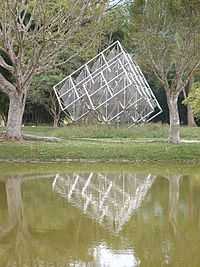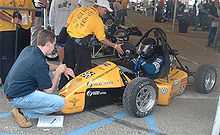Simón Bolívar University
Coordinates: 10°24′37″N 66°52′52″W / 10.4104°N 66.8812°W
| Simón Bolívar University | |
|---|---|
| Universidad Simón Bolívar | |
 | |
| Motto | "La Universidad del Futuro" |
Motto in English | "The University of the Future" |
| Established | 1967 |
| Type | Public |
| Rector | Enrique Planchart |
Academic staff | 850(approx.)(2011) |
| Students | 7.011 (approx.) (USB 2011) |
| Undergraduates | 5.365 (5 yr) y 1.646 (3 yr) (approx.) (2011) |
| Postgraduates | 1.282 (approx.) (2011) |
| Location |
Sartenejas, Miranda State, Venezuela 10°24′38.09″N 66°52′52.33″W / 10.4105806°N 66.8812028°W |
| Colors | Yellow |
| Website | www.usb.ve |

Simón Bolívar University (Universidad Simón Bolívar in Spanish) or USB, is a public institution located in Miranda State, Venezuela with scientific and technological orientation.
History
On May 1967 the government created a commission composed by Luis Manuel Peñalver, Luis Carbonell, Mercedes Fermín, Miguel Angel Pérez and Héctor Isava to study the possibility of creating a new university that would offer studies to directly promote the economic and social development of the country. On July 18, 1967 the President of Venezuela Raúl Leoni signed a decree which officially founded the University as an Instituto Experimental de Educación Superior focused mainly on scientific and technological research. The original name given to the university was Universidad de Caracas; however, the first name of the Central University of Venezuela was also "Universidad de Caracas" and it was still known by that name. Members of The National Academy of History, the Bolivarian Society of Venezuela and other important institutions expressed their wish to relate the name of El Libertador Simón Bolívar to the name of the recently created university, which resulted in the change to the name of Universidad Experimental Simón Bolívar in 1969. Ernesto Mayz Vallenilla was the rector when president Rafael Caldera inaugurated the University on January 19, 1970.
From the confluence between the name "Universidad Simón Bolívar" and its slogan "The University of the Future", the Venezuelan designer, Gerd Leufert developed the design inspired by the photographic reproduction of an electrical circuit. The figure includes eight semicircular lines and a small rectangle in the center of them, forming a structure similar to a rounded pyramid, whose meaning is that of a gateway, which represent the unity of various knowledges and their projections into the future.
As 2010, the Simón Bolívar University has over 38,000 alumni[1]
Campus
Location

The closed-campus-style grounds are located in the Sartenejas valley, in the municipality of Baruta, Miranda State. Its total surface is approximately of 3,489,000 m².
Degrees


It offers the following undergraduate programs (B.Sc.):
- College of Sciences:
- College Architecture and Urbanism:
- Architecture
- Urban Planning
- College of Engineering:
- Geophysics
- Electrical
- Electronics
- Computer
- Maintenance
- Mechanical
- Chemical
- Production (Industrial)
- Materials
- Telecommunications
- Associate's degrees:
- Electrical
- Electronics
- Mechanical
- Aeronautic maintenance
- Hotel Administration
- Tourism Administration
- Transport Administration
- Customs Administration
- Foreign Trade
- Organization Management
It offers the following graduate programs (M.Sc., Ph.D. and Specializations):
- College of Applied Sciences:
- M.Sc. and Ph.D. in Biology
- M.Sc. and Ph.D. in Computer Sciences
- Ph.D. in Interdisciplinary Science
- M.Sc. and Ph.D. in Physics
- M.Sc. and Ph.D. in Mathematics
- M.Sc. and Ph.D. in Chemistry
- M.Sc. and Ph.D. in Nutrition
- M.Sc. and Ph.D. in Food Science
- Specialization in Clinic Nutrition
- Specialization in Quality Control and Evaluation of the Food Industry
- College of Engineering and Technology:
- Ph.D. in Engineering
- M.Sc. in Statistics
- Specialization in computational statistics
- Specialization in Telecommunications
- Specialization in Telecommunication Management
- M.Sc. in Biomedicine Engineering
- M.Sc. in Electronic Engineering
- Specialization in Telematics
- Specialization in Electricity distribution
- Specialization in Electric Installations
- Specialization in Power Systems
- Specialization in Electric Energy Transmission
- M.Sc. in Electric Engineering
- M.Sc. in Earth Sciences
- M.Sc. in Mechanical Engineering
- Specialization in Manufacturing and Maintenance
- Specialization in Design and Industrial Maintenance
- Specialization in Structural Engineering
- Specialization in Geotechnical Engineering
- Specialization in Plant Processes Engineering
- Specialization in Industrial Systems
- Specialization in Rotary Equipment
- M.Sc. in Chemical Engineering
- M.Sc. in Material Engineering
- M.Sc. in Systems Engineering
- College of Social and Humanistic Sciences:
- M.Sc. and Ph.D. in Political Science
- Specialization in Public Opinion and Political Communication
- Specialization in Environment Management
- M.Sc. in Environment Development
- Ph.D. in Sustainable development
- M.Sc. in College Education
- Specialization in Informative Education
- Specialization in Public Transportation
- M.Sc. in Public Transportation
- M.Sc. and Ph.D. in Philosophy
- Minor in Philosophy
- M.Sc. in Business and Administration
- Specialization in Project Management
- Specialization in Organizational Development
- Specialization in State Audit Management
- Specialization in Finance Management
- Specialization in Market Management
- Specialization in Business Management
- Specialization in Technology Management
- Specialization in Natural Gas Business Management
- Specialization in English
- Specialization in Math Teaching for High School Level
- M.Sc. in Applied Languages
- Ph.D. in Literature
- M.Sc. in Latin American Literature
- M.Sc. in Music
- M.Sc. in Psychology
Extracurricular activities

Traditions



Several myths and legends are part of the student's culture:
La Cebolla: The logo of the university is called "La Cebolla" or "the onion" in Spanish in contrast to its technological symbolism (it was inspired by the photograph of an electric circuit). It was designed to represent a group of doors one into another, a metaphor for the hard work and effort students have to do in order to walk from the big door that leads them in, to the little one that leads them out (see ).
A brief history and description: The sculpture creation starts at 1975 when Gabriel Martin Landrove, a young USB's architect student, won an institutional contest. A long time of constructions took place until July 5 of 1991 when PHD Professor Stefan Zarea conducted the final works an inaugurated it.[2] The artistic concept was inspired on the morning dew condensed over a tree sleeve falling down into another one. The sleeves are represented with 576 metal trowel arranged as a matrix 48x12 in a conical truncated structure that allow the water to create multiple and smalls waterfalls. This huge structure can rotate over its own vertical axis and the movement is produced by a Pelton wheel dispose at the lower level of the conical structure. The rise of the water to the top and its rotational momentum is produced by hydroulic force drive by an electrical pump. There is also a tree level shallow pool, a top circular viewer and an intricate circular walk sides that complements the design.
The University turns it on during special occasions, like graduations, and since 2008 is under heavy maintenance program. On January 19, 2010, the Maintenance Department finished the second stage of its restoration with the restart of the conical structure including their rotational movement. It is left for the close future, the restoration of the mirror pools, water filtration systems and night illumination.
http://www.youtube.com/watch?v=EhnGmfkFh3Q http://www.youtube.com/watch?v=qNevGd0pTYQ
For more history information see
- ↑ http://www.usb.ve/pdf/dip_nov_2010.pdf
- ↑ La Universidad Simón Bolívar a través de sus símbolos. 2005. Maria Teresa Jurado de Baruch. Editorial Equinoccio. Sartenejas, Baruta.
External links
| Wikimedia Commons has media related to Universidad Simón Bolívar. |
- (Spanish) Universidad Simón Bolívar
- (Spanish) Alumni Web Site
- (Spanish) LaSimonTV
- (Spanish) El Ampere Online, Unofficial Universidad Simón Bolívar Alumni Site
- (Spanish) USB Solar Venezuela, first solar car team in Venezuela
- (Spanish) USB Fire Department
- (Spanish) USB HNMUN Delegation
- (Spanish) USB WORLDMUN Delegation
- (Spanish) USB LAMUN Delegation
- (Spanish) Interactive Map of Sartenejas Campus